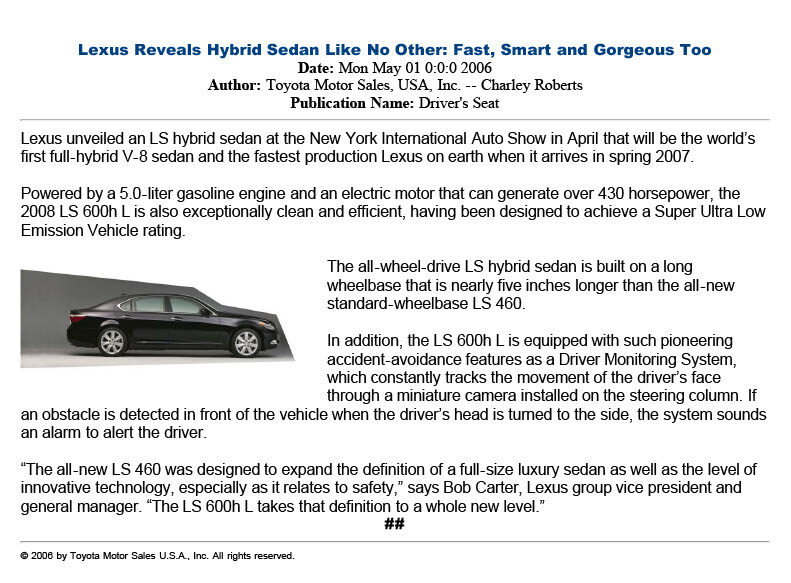April was National Distracted Driving Awareness Month, a time for self-reflection and advocacy for not driving distracted. Don’t balance your mega-sized drink between your knees while one hand holds a double-bacon cheeseburger and the other steers the car, and do not answer your emails and text messages while driving. Every person knows distracted driving is dangerous, but for reasons unknown, we continue to attempt multitasking while driving. NHTSA reports an average of more than 3,000 vehicular fatalities per year in the United States are caused by distracted driving.
What Does My Car Know & Who Is It Telling?
Will our cars become all-knowing with the advent of Artificial Intelligent (AI) and Machine Learning (ML)? We live in a data-driven society where industries rely on data collection to improve safety, elevate customer experiences, and increase sales. Data is everything in today’s electronic world. Sensor technologies can keep passengers safer through data collection, so what should car and tech lovers care about?
Data is the equivalent of gold to whoever owns or possesses the ability to access it. Understanding what data is collected, who has rights to it, and under what conditions it may be accessed and used is important. The “rules” may change as legislation and safety standards evolve, and the rights to occupant data may flex depending on the circumstances. If you own the vehicle, the data should belong to you, but what if you loan it out as part of a shared mobility platform? Law enforcement may retain the rights to data via court orders for accident investigations, whereas automakers may use it for recalls or standard maintenance conducted via over-the-air (OTA) updates.
Efforts to reduce driver distraction have been focused on three primary areas: ad campaigns and public service announcements to educate and provide awareness, law enforcement efforts with more than 20 U.S. states prohibiting the use of hand-held devices while a vehicle is in motion, and more technology in cars to protect us from ourselves.
History of In-Vehicle Monitoring Systems
Toyota is credited with introducing driver monitoring systems (DMS) in 2006. The technology uses infrared sensors to monitor a driver’s alertness and interact with collision avoidance technologies, or pre-collision systems, to alert and reengage the driver to avoid a crash. Since this time, many, not all, automakers have evolved DMS technologies to include other vehicle passengers by integrating occupant monitoring systems (OMS), hence increasing the overall safety of passengers and the associated safety rating of their products. Today’s OMS will include features many consumers rely upon and seek out when determining their next vehicle purchase.
The most common features which increase safety by actively avoiding or mitigating the effects of an accident include airbags – mandatory in 1999 for all passenger cars, light trucks, and vans (front seat) – and antilock brakes, required in 2000 for all new passenger cars. Add to the list backup cameras, electronic stability control, seat belts, tire pressure monitoring systems, and all ADAS technologies.
Newer occupant safety features can measure biometric attributes, including driver gaze and alertness, weight, and position to issue alerts and determine which airbags to deploy. Future OMS features will be multi-purposed, detouring impaired or drunk driving with a built-in breathalyzer. Other OMS innovations can detect medical emergencies, pull the vehicle to the side of the road, and contact first responders.
Meanwhile, a combination of smartphone technologies, fingerprints, or other biometrics can reduce vehicle theft. The same technologies can be used to customize the in-vehicle experience and activate the preferred settings upon recognition of the driver, taking convenience and luxury to an entirely new level.

Cybersecurity & Cyber Safety
It is okay to be excited about new technologies while also being concerned about possible issues, especially with the introduction of in-vehicle monitoring. For some, this conjures thoughts of George Orwell’s classic book, 1984, with images of “Big Brother” knowing and watching all. Others will be wowed by the convenience the tech will introduce into their lives.
In the case of automotive Internet-of-Things (IoT), synching your smartphone to your car might trigger information sharing between phone applications and the vehicle. Depending on the Terms and Conditions of the app (we know you don’t read them!), your data may be used to inform the vehicle of your preferred habits or traits. Convenience or scary tech? You be the judge.
Cybersecurity to protect and preserve user data is the most benign scenario, however. Car hacking is a popular topic as vehicles evolve into computers on wheels versus simple modes of transportation. The scenarios of breaches in cyber-physical systems involve using a digital or cyber connection to manipulate the function of a physical device, in this case, a car. Whether disruption to lines of code operating the electronic components or tangible access to the car via remote, these types of entry into the vehicle are a growing concern.
Automakers take great care to integrate redundancy into vehicles, so there must be multiple points of failure to cause a severe cyber safety concern – at least at the time of purchase. OTA updates and other service and maintenance requirements may be required to “patch” software gaps identified in cars. These may be forced updates, or they may require acceptance, such as with a smartphone or other device. The technology is new, and the possibilities for how it will both help and hinder our lives are in perpetual development. But understanding what data is being exchanged, who owns it, how it may be used, and how you might disable the collection of your data are important for deploying and using technology responsibly.


